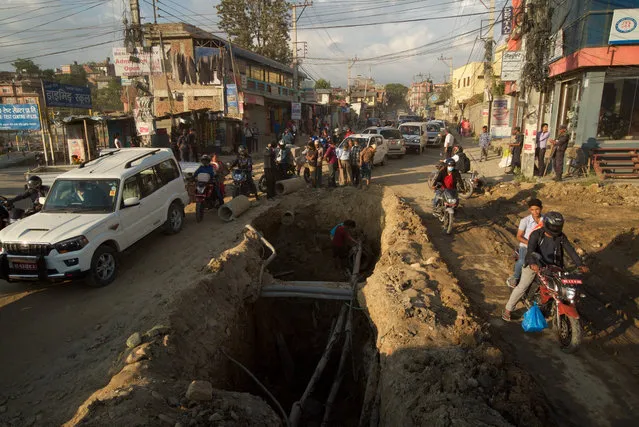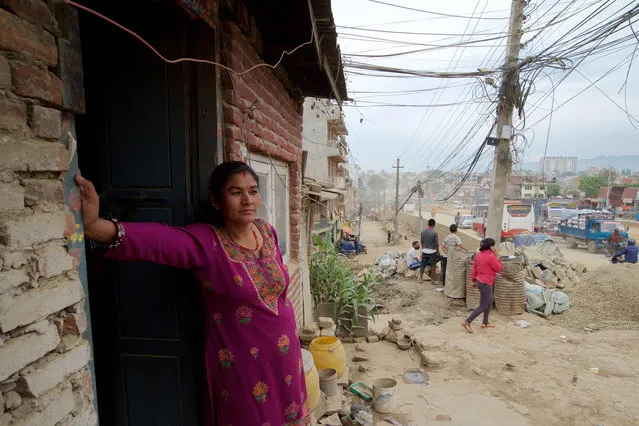
As the government ploughs on with its controversial road expansion scheme, commuting in Nepal’s capital can take up to four hours – while many joke that the dust mask has become part of the national dress. (Photo by Pete Pattisson/The Guardian)

In 2011 Nepal’s then prime minister, Baburam Bhattarai, launched a road expansion programme in the capital, Kathmandu. Seven years later, the controversial project is still running. Opponents argue it has increased air pollution, damaged cultural heritage sites and caused major congestion. Supporters say the new roads – especially the expansion of the city’s ring road – are vital for the country’s development. (Photo by Pete Pattisson/The Guardian)

The expansion of Kathmandu’s ring road has left commuters choking on dust and caught in hour-long traffic jams. Groups opposed to the road expansion also claim it is threatening the city’s cultural heritage. “(Road expansion) is displacing the indigenous Newar people from their own land. Lots of heritage sites will be affected … Kathmandu needs to be preserved”, says Suraj Maharjan of the Save Nepa Valley campaign. (Photo by Pete Pattisson/The Guardian)

Bhai Kaji Tiwari, development commissioner of the Kathmandu Valley Development Authority dismissed the concerns of anti-road expansion groups, saying: “(Opponents of the road expansion) are angry now, but afterwards they will enjoy it. It will be good for business and the environment will be better”. (Photo by Pete Pattisson/The Guardian)

The widening of Kathmandu’s ring road is at the heart of the programme and is seen as a driver for economic development. The government is now planning to build an outer ring road. (Photo by Pete Pattisson/The Guardian)

Rambika Thapa Magar stands outside her one room home on the edge of Kathmandu’s ring road. The expanded road is due to cut through the middle of the house. “We have been told to evacuate. The demolition could started at any time, maybe while we are sleeping. We have nowhere else to go”, said Rambika. (Photo by Pete Pattisson/The Guardian)

The construction of the city’s first underpass at Kalanki is both a source of pride and frustration. Vehicles can wait for an hour to pass through the junction. (Photo by Pete Pattisson/The Guardian)

Tired of waiting for their bus to pass through the Kalanki junction, commuters decide to walk. (Photo by Pete Pattisson/The Guardian)

Shova Regmi spends four hours a day commuting to and from work. “It’s very difficult now. My health is bad. It’s like I’m suffocating. It creates a lot of stress, but it will be better in the future”. (Photo by Pete Pattisson/The Guardian)

“There’s too much dust. When I spit, it comes out black. There is no disabled access anywhere. Our leaders talk about disabled access, but there is no access even in Singha Durbar (a complex of government ministries)”, says Govinda Khanal, a former teacher. (Photo by Pete Pattisson/The Guardian)

Kathmandu’s chaotic electrical wiring has further hampered road expansion. As roads have been widened the electricity poles have also had to be moved, but a lack of co-ordination between the roads and electricity departments has held up progress. (Photo by Pete Pattisson/The Guardian)

As sections of the ring road have been completed, police have warned of a new danger: speeding drivers. The sign in the bottom left corner reads, “Accident record in the last six months: 73 injured, 3 dead”. (Photo by Pete Pattisson/The Guardian)

People in Kathmandu joke that the face mask has now become part of the national dress – an indispensable accessory in an effort to protect themselves from the dust. Nepal has the worst air quality in the world, according to the Environmental Performance Index. (Photo by Pete Pattisson/The Guardian)
22 Jun 2018 00:05:00,
post received
0 comments
